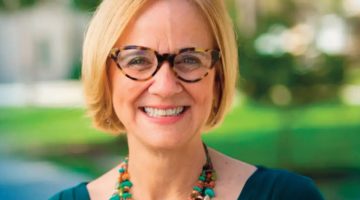Tampa, Fla. (AP) – In 1900, the Tampa City Council agreed to stake off Woodlawn Cemetery’s “colored section.” During the era of segregation, it was a move that ensured the area would be visibly separated from the rest of the 40-acre Tampa Heights burial ground.
Stakes still mark three sides of that section. They help locate what was one of at least eight turn-of-the-century burial grounds for the Tampa area’s Black residents.
The others were not so easy to find. Each was erased, built over and then discovered due to Tampa Bay Times investigations spanning four years.
It was previously believed that the now-integrated Woodlawn’s original Black section was also erased, possibly located on vacant cemetery land now owned by Greater Tampa Showmen’s Association that was for sale last year.
Rebecca O’Sullivan, an archaeologist with Stantec, found its true location by tracking Woodlawn’s early 20th century burials. She realized it was still staked off.
Her discovery might end the search for Tampa’s missing segregation-era Black burial grounds and provide further clarity for why some were erased.
From the start, the best guess was that racism was behind the erasures. Four years later, that remains the theory, but with more context. Some of the cemeteries might not have been targeted because they were Black cemeteries or because they were on Black-owned land. Some might have disappeared due to both factors.
“That could be right,” said Paul Jones, program manager for Stantec, the firm that performed the archaeological survey proving Tampa’s Zion Cemetery was erased and covered by developments. “But the problem is that the people responsible are not around to respond to our questions. So, it’s like any historical issue _ without having firsthand knowledge, it ends up being supposition.”
In 1919, with the other Black cemeteries filling up, East Tampa’s Memorial Park Cemetery for Black burials was established. It remains in operation and shares a distinction with Woodlawn: it had white owners.
Woodlawn was operated by the city, which had only white leaders at the time.
All but one of the erased cemeteries were Black-owned. Is that a coincidence?
Possibly, Jones said, but doubtful. “Like all the Jim Crow South, disenfranchising, any minority and especially African Americans, was the pastime of many. The Black community had no political power or financial wherewithal to protect themselves. They were obvious targets for people who wanted to take advantage of them.”
It is unclear what came of Oaklawn Cemetery’s Black section. Today that property is a city parking lot.
Marti-Colon Cemetery’s Black section _ the other white-owned Black burial ground _ was sold to the city, abandoned and then purchased by a developer. Today, that property is a shopping plaza.
The Port Tampa Cemetery was taken via eminent domain and the land became part of MacDill Air Force Base.
Wrongful taxation was the mechanism used to erase the others. Those are:
Zion Cemetery, now under Robles Park Village housing projects, warehouses and a tow lot.
College Hill Cemetery’s Black section, located on land that today is the Italian Club Cemetery’s Parking lot. St. Joseph’s Aid Society Cemetery, located on land that today has four East Tampa homes on it.
Keystone Park Memorial Cemetery, located on land that today is an Odessa horse farm.
Each was taken from the Black owners spanning the 1920s through 1940s when property taxes were not paid. Except that cemeteries are not supposed to be taxed.
White cemeteries were also incorrectly taxed in that era, but the owners successfully petitioned to have the fees waved, according to Tampa City Council and Hillsborough County Commission minutes from that era.
Those minutes also show Black churches and masonic clubs having erroneously levied taxes waved by the governing bodies because they, too, were exempt. There is no mention of the Black-owned cemeteries.
“There is no proverbial smoking gun, but there is a clear difference,” the Tampa Bay History Center’s Rodney Kite-Powell said. “Those other properties had large physical entities that needed to be cleared. To clear the cemeteries, all they had to do was remove the headstones.”
So far, archaeologists have only surveyed and confirmed that bodies are still buried at Zion and Port Tampa cemeteries.
The search for erased cemeteries began in 2018 when researcher Ray Reed told the Times about death records he discovered for Zion.
Since then, Reed has combed Tampa death records through 1950 and compiled a list of the missing cemeteries and those buried in each.
Every cemetery on his list has been located, as research shows the remaining two names are most likely duplicates. Robles Pond Cemetery is likely Zion, which was in the Robles Pond neighborhood, and Cottage Hill and College Hill cemeteries are also likely the same. Reed disagrees that Robles Pond Cemetery is Zion. This could mean the search for Tampa’s erased Black cemeteries is finished.
If the work is complete, finding Woodlawn’s Black section provided an appropriate end, O’Sullivan said. It is unclear how many are buried there There are less than 40 headstones but there are likely unmarked graves due to headstones being lost to time or families being unable to afford one.
Among those with a headstone is Martha Ardis.
Death certificates indicate that only nine of Zion’s nearly 1,000 graves were relocated. Among those moved was Ardis.
The Times discovered her Woodlawn headstone while searching for that section of the cemetery.
“That’s great,” said O’Sullivan, who has worked with the Times since the start of the search for erased cemeteries. “Full circle.”
Still, Woodlawn’s Black section is also a reminder of a “terrible reality,” Kite-Powell said. “If you were Black and buried in Tampa” in the late-19th and early-20th century, “unless you were one of the few buried in Woodlawn, your grave was erased.”













No Comment